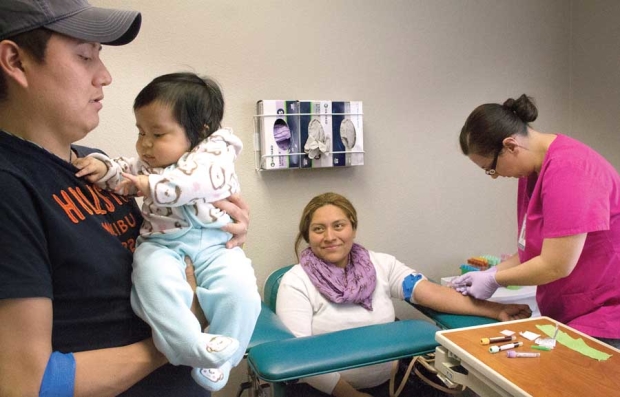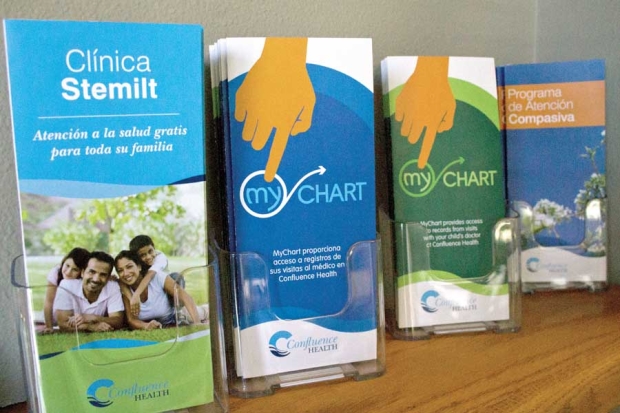
Stemilt Growers employee Alfonso Perez holds his 6-month-old daughter, Lexi Amaya, while wife Claudia Rea has blood drawn March 29, 2016, as part of her wellness exam at the Stemilt Family Clinic in Wenatchee, Washington. (Shannon Dininny/Good Fruit Grower)
Alfonso Perez worked full time in the restaurant industry for 12 years, including some major chain restaurants, and never had health insurance.
Two months ago, he accepted a full-time job palletizing for Stemilt Growers, one of the world’s largest growers and packers of apples, pears and cherries in Wenatchee, Washington.
The job came with health benefits and, even better, an on-site health clinic, with a pharmacy, offering primary and preventative care for the company’s 1,500 full-time employees, seasonal workers and their dependent family members.
Perez, 32, is married with two children, a boy, age 6, and a 6-month-old girl.
Across the country, companies are seeking ways to reduce spiraling health costs, and in many cases that means increasing employees’ share of the financial burden through higher co-pays and deductibles.
The agriculture industry is no exception, despite relying heavily on seasonal laborers who often don’t receive health benefits.
But companies also increasingly are implementing creative programs designed to cut costs by improving the overall health of their employees, through wellness programs and on-site health clinics, offering everything from smoking cessation and diabetes classes to lab work and women’s health care.

The Stemilt Family Clinic provides educational brochures for its 1,500 full-time employees, seasonal workers and dependent family members who might visit the clinic. Since opening in September 2015, the clinic already has 700 patients. (Shannon Dininny/Good Fruit Grower)
Companies using these programs say they tend to reduce absenteeism in the workplace, and in an industry facing a growing shortage of workers, they serve as a magnet that separates one company from the next.
“It’s a big draw,” Perez said. “This clinic is a big thing for this community. It’s a great benefit, and a lot of people probably won’t leave because of it.”
Occupational health first
Several agricultural employers began offering occupational health programs in recent years to better treat injuries and urgent health care needs on the job.
In Washington, more than a half-dozen growers and packers have signed on with a company that staffs on-site clinics for occupational health, treating cuts and serving as first-responders in the event of a serious injury.
Five more have expressed interest, according to Dan Hansen, customer relations lead for Spokane, Washington-based AnovaWorks.
The company provides the full scope of occupational medicine — first aid, urgent and injury care, flu shots — and handles workers’ compensation claims. Anyone with an injury on the job can drop into a clinic and get back on the job quickly, if able.
The scale of services varies based on each company’s needs and wants, Hansen said.
One company, Underwood Fruit and Warehouse Co. in the tiny town of Bingen, Washington, partnered with a local lumber company to open such a clinic, with each employer paying roughly half the cost.
“One of the appeals for these employers is that we’re flexible and can adjust as the seasonable labor needs adjust throughout the season,” Hansen said.
In addition, AnovaWorks’ programs are set up in a way that other wellness programs can be added on if the fruit company chooses. Many are deciding to do so, he said, in a new thrust toward improving workers’ “industrial fitness” to improve employees’ overall health and keep them on the job.
Similar efforts are being examined elsewhere. In Washington’s Yakima Valley, one local hospital that offers diabetes prevention and management classes has had talks with local fruit companies about offering classes on-site for workers at packing houses, though none have signed on yet.
Fit to work
Stemilt hired AnovaWorks for its occupational medicine program, and also offers a wellness program to help employees address specific health concerns, such as quitting smoking.
But the company found that many employees didn’t have access to or follow-through on the kinds of preventative care that can often lower a company’s overall employee health costs.
In a partnership with Confluence Health, the company opened an on-site medical clinic and pharmacy in September 2015.
The clinic, with several exam rooms and a pharmacy, offers everything from wellness and physical examinations to vaccinations, prescriptions and blood work that is sent to an outside laboratory.
Prescriptions from the pharmacy are free of charge.
The clinic doesn’t intend to compete with existing primary care providers in the area, but can serve as a primary care provider for employees and seasonal workers who might otherwise not have one, said Stemilt spokeswoman Brianna Shales.
Diagnosis and treatment of chronic diseases, including diabetes and hypertension, has been the biggest success at the clinic since it opened, said on-site physician Dr. Christian Kovats, and patients already are seeing improvements in their health.
When the clinic first opened in September, Kovats said, many diabetic patients did not have a glucose machine or the materials to use those machines, the test strips, that are the most expensive part of diabetes care.
Now, they have those test strips and machines and the patients are bringing down their blood sugar levels — some by as much as 50 percent.
Pre-diabetic patients also are being caught early enough to stop onset of the disease; one man lost 15 pounds after learning he was pre-diabetic, he said. And because medications are free at the on-site pharmacy, they’re motivated to fill them and take them.
Most important, Kovats said, “They’re engaged. They’re figuring it out.”
Kovats currently sees about 700 Stemilt employees and their family members, with room to grow the practice.
The clinic aims to treat 18 to 20 patients per day, and is aiming to convert a fourth exam room for massage therapy to treat the most common ailment — upper back pain — among the workers Kovats calls “industrial athletes.”
It’s still too soon to know whether the clinic and pharmacy are lowering Stemilt’s health costs, Shales said, but the company is seeing its lowest absenteeism rates.
Company President West Mathison believes in the program enough that he’s walked the packing lines on each shift specifically to help promote the clinic to workers.
“We really do believe preventative care is how we can reduce our health care costs,” Shales said. •
– by Shannon Dininny






Well written article. Thanks for saying it so well.
The answer is in for the Occupational Medicine portion of healthcare at Stemilt. It saves money.